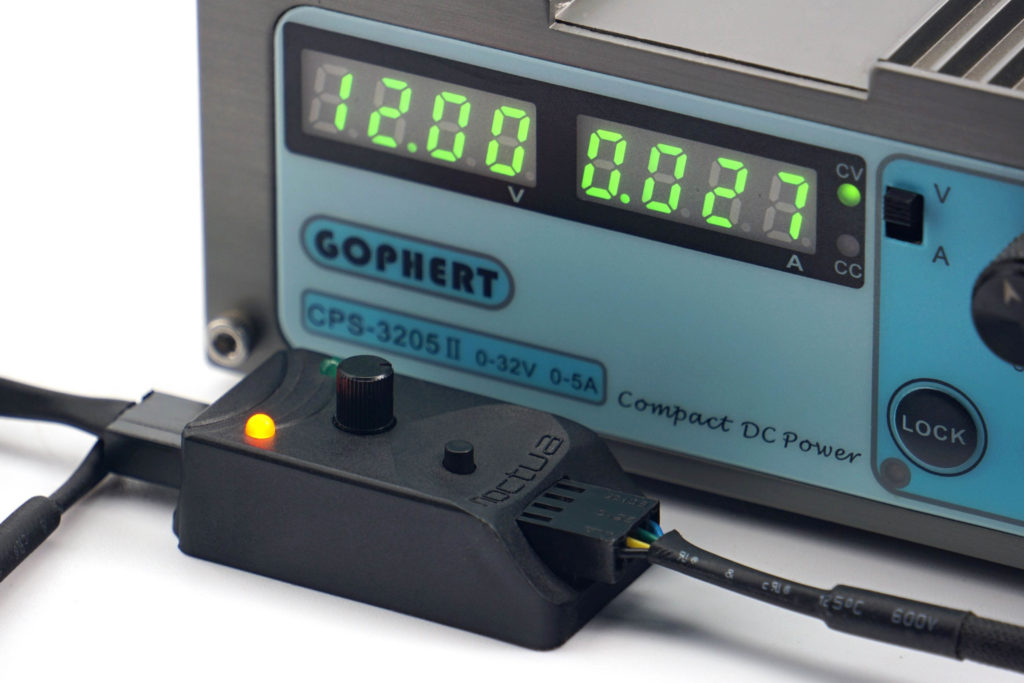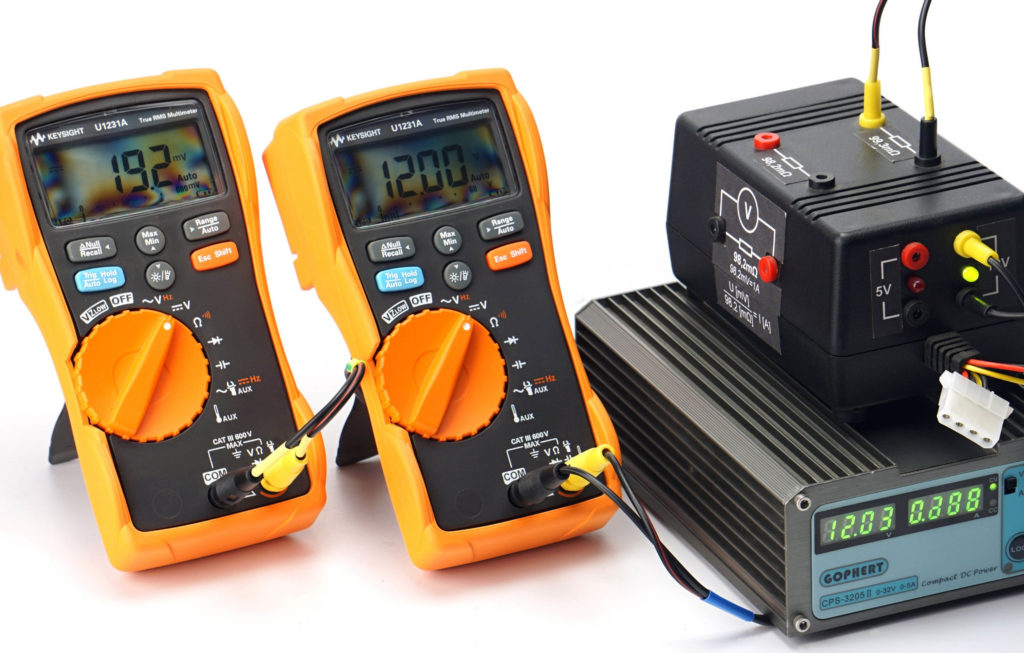How we measure power draw and motor power
The first Fluctus 120 PWM fans marked a great qualitative progress in SilentiumPC production (now Endorfy). Nevertheless, they had their flaws, which the developers are gradually eliminating and, based on the measurement results, the newer 140 mm Fluctus can be said to be a clear improvement. The Fluctus 140 PWM ARGB stands out nicely from other fans in its price category.
How we measure power draw…
Is it worth addressing the power draw of fans? If you have seven of them in your computer (three on the radiator of the cooler and four for system cooling in the case) and they are also backlit, the power draw starts at tens of watts. This makes it worth dealing with.
All fans are powered by Gophert CPS-3205 II laboratory power supply. It is passive and virtually noiseless, so it does not distort our noise level measurements. However, for the PWM fans, a Noctua NA-FC1 controller is connected through which the fans are regulated. We also have a shunt between the power supply and the Noctua controller. On it, we read the voltage drop, from which we then calculate the current. However, the voltage on the power supply is set so that 12 V goes to the Noctua NA-FC1. We then also set the exact 12 V to measure the maximum power of the 3-pin linear power supply fans.
In the power draw tests, we will be interested in the power draw in fixed noise level modes in addition to the maximum power consumption at 12 V or 100% PWM. That is, at those settings at which we also measure other parameters. Finally, in the graphs you will also find the power consumption corresponding to the start-up and minimum speeds. The difference between these two settings is that at start-up speed you need to overcome the frictional forces, so the power draw is always higher than at minimum speed. At these, the fan is already running and just reduces power to just before a level where it stops.
These start-up and minimum power draw data are a substitute for the start-up and minimum voltage information. You often encounter this when reading about fans, but with PWM fans there is no point in dealing with it. And although it is possible to power a PWM fan linearly, it will always perform better with PWM control – lower starting and minimum speeds. Therefore, it would be unfair to compare these parameters for all fans using linear control. That way, fans with PWM would be disadvantaged and the results distorted.
…and motor power
In addition to power draw, it is important to consider one more parameter that is related to the power supply – the power of the motor. This is usually listed on the back on a label and is often mistaken for power draw. However, the voltage and current indication here is usually not about power draw, but about the power of the motor. The latter must always be well above the operating power draw. The more, the longer the life expectancy of the fan.
Over time and with wear, fan friction increases (through loss, hardening of the lubricant, dust contamination or abrasion of the bearings, etc.). However, a more powerful motor will overcome the deteriorating condition of the fan to some extent, albeit at a higher power draw, but somehow it will cope. However, if the difference between the motor power and the operating power draw of the new fan is small, it may no longer be able to exert sufficient force to turn the rotor under increased friction due to adverse circumstances.

To test the power of the motor, we set the fan to full power (12 V/100 % PWM) and increase the mechanical resistance by braking the rotor in the middle. This is a higher load for the motor, with which the power draw naturally increases. But this is only up to a point, until the rotor stops. The power of the motor in our tests corresponds to the highest achieved power draw that we observed when the fan was being braked.
We use the Keysight U1231A high sample rate precision multimeters to analyse motor performance (as well as normal operating power draw). In addition, the individual samples are recorded in a spreadsheet, from which we then graph the maximum. The final value is the average of three measurements (three maximums).
- Contents
- Endorfy Fluctus 140 PWM ARGB in detail
- Basis of the methodology, the wind tunnel
- Mounting and vibration measurement
- Initial warm-up and speed recording
- Base 6 equal noise levels…
- ... and sound color (frequency characteristic)
- Static pressure measurement…
- … and airflow
- Everything changes with obstacles
- How we measure power draw and motor power
- Measuring the intensity (and power draw) of lighting
- Results: Speed
- Results: Airlow w/o obstacles
- Results: Airflow through a nylon filter
- Results: Airflow through a plastic filter
- Results: Airflow through a hexagonal grille
- Results: Airflow through a thinner radiator
- Results: Airflow through a thicker radiator
- Results: Static pressure w/o obstacles
- Results: Static pressure through a nylon filter
- Results: Static pressure through a plastic filter
- Results: Static pressure through a hexagonal grille
- Results: Static pressure through a thinner radiator
- Results: Static pressure through a thicker radiator
- Results: Static pressure, efficiency by orientation
- Reality vs. specifications
- Results: Frequency response of sound w/o obstacles
- Results: Frequency response of sound with a dust filter
- Results: Frequency response of sound with a hexagonal grille
- Results: Frequency response of sound with a radiator
- Results: Vibration, in total (3D vector length)
- Results: Vibration, X-axis
- Results: Vibration, Y-axis
- Results: Vibration, Z-axis
- Results: Power draw (and motor power)
- Results: Cooling performance per watt, airflow
- Results: Cooling performance per watt, static pressure
- Airflow per euro
- Static pressure per euro
- Results: Lighting – LED luminance and power draw
- Results: LED to motor power draw ratio
- Evaluation











I have several general questions.
I see how the exhaust airflow pattern is often commended on. By how much does airflow pattern affect cooling performance? For example, assuming two fans have identical airflow rate on a thin radiator. One fan has cylindrical exhaust while the other has conical exhaust. Alternatively, one has a larger fan hub and the other has a smaller one. Or just different blade design in general. Does cooling performance differ, and if so, by how much? How about for case fans? How about on the intake side, does airflow pattern differ there?
The wind tunnel is made free of dust before testing. By how much does dust settled on the wind tunnel/fan blades etc affect airflow and noise? Would a thin layer significantly affect the results?
Great questions. We have had the ones from the first paragraph jotted down for a while and we will deal with them later in specialized tests. We just have to work our way through the other topics. 🙂
As for the effect of fan “dirtiness” on air flow, I wonder how this could be tested. Of course, we keep the wind tunnel as clean as possible (it is even stored in a vacuum chamber) and I don’t think it is a good idea to risk changing the friction or reducing the anemometer speed by some sediments from the tested fan. But we’ll figure something out. For this purpose we could use some of the prototype tunnels that preceded the final one we are using. They have some imperfections, but they should be suitable for this purpose.
I’m in love with these deeply scientific reviews. No other reviewer, ever, anywhere, went to such lengths and details in their reviews, especially about pc fans. Because of them I’m getting now 2x Endrofy Fluctus 140 argb for a top exhaust on case with grill+ dust filter. Having read all other reviews, I do prefer them over Pure Wings 3, they seem to be more efficient and more quiet at similar settings.
Thank you!